Abstract
Turfgrass use in semi-extensive green roofs might provide an additional solution for establishing green roofs in urban city centres. The aim of the present study was: (a) to investigate the effects of two extensive green roof substrates formulated from mixing locally available materials with two different organic amendments (peat and locally produced compost) in volumetric proportions as indicated by their subscripts S15:Pum40:Per20:P20:Z5, and S15:Pum40:Per20:C20:Z5 (where S = sandy loam soil, Pum = pumice, Per = perlite, P = peat, Z = zeolite and C = compost), and two substrate depths (7.5 cm or 15 cm) on the growth of Zoysia matrella ‘Zeon’; and (b) to evaluate the effect of various substrate types and depths on the drought tolerance of Z. matrella under two irrigation regimes (3 mm or 6 mm of irrigation every 3 days). The measurements included the determination: (a) of substrate characteristics, and (b) both turfgrass quality and physiological status as indicated by the green turf cover (GTC), normalized difference vegetative index (NDVI) and stomatal resistance. It was found that during the establishment and growth period, the compost-amended substrate improved the GTC compared with those amended with peat. In contrast substrate S15:Pum40:Per20:P20:Z5 improved the drought tolerance of Z. matrella during the drought period compared with the compost-amended substrate. Deeper profiles improved the establishment, growth and drought tolerance of turfgrass compared with the shallower profiles. All three factors (substrate type and depth and irrigation regimes) proved to be influential for turfgrass growth and quality during the drought stress period. During the drought period, the GTC and NDVI were higher and stomatal resistance was lower for the peat-amended substrate, the deeper profiles (15 cm) and the higher irrigation regime (6 mm every 3 days).
Introduction
The limited open spaces of contemporary cities have led to the evolution and application of technological solutions that aim to augment urban green spaces within the existing built space. Green roofs are such technological solutions with numerous environmental and aesthetic advantages (Getter and Rowe Citation2006, Dunnett and Kingsbury Citation2010). However several of these advantages, such as storm water management and amelioration of the urban heat-island effect, are feasible only if green roofs are implemented in adequately large scales (Akbari et al. Citation2001, Getter and Rowe Citation2006).
City areas prone to the urban heat-island effect are most frequently located in older city parts that are occupied by old buildings. As a result any solution for greening existing buildings must include lightweight constructions. In those cases extensive green roofs are considered as the optimal solution for greening roof tops. Extensive green roofs are lightweight systems with minimal substrate depth varying from 5–15 cm and with minimal maintenance requirements (FLL Citation2008). Only limited plant species can survive in such shallow depths in conjunction with the unfavourable hot and dry semi-arid conditions of several Mediterranean cities. These plants are usually succulents and other Crassulacean acid metabolism (CAM) plants with increased drought tolerance.
Despite their numerous environmental advantages extensive green roofs have been restrained mostly to temperate and cold climates due to the more favourable environmental conditions that provide sustainable plant growth. In contrast in Mediterranean countries extensive green roof construction is limited due to the unfavourable summer climatic conditions characterized by increased temperature and solar irradiation and the almost complete lack of rain. In addition, in Mediterranean countries green roof construction has been restrained by the lack of governmental incentives (Nektarios et al. Citation2011a, Kotsiris et al. Citation2012b).
In the absence of governmental incentives, people are prone to ignore the multiple environmental benefits of green roof systems and are reluctant to support the construction of extensive green roofs with succulents and CAM plants due to the inaccessibility of these groundcovers and their restricted utilization as functional open urban green spaces. On the other hand turfgrasses have the unique ability to serve all of the three requirements of plants that are used in the urban environment, namely aesthetics, function and recreation (Beard and Green Citation1994).
Based on the existing green roof guidelines the use of turfgrasses on extensive green roofs is restricted to climates with adequate natural precipitation since their drought tolerance is inferior to that of CAM succulent plants. In addition, they require substrate depths of at least 10 cm according to the FLL (2008) guidelines. However this formulaic approach of strictly distinguishing green roof types has recently raised several criticisms. Instead of the formulaic approach an adaptive approach is proposed since green roof categorization should be based on the local conditions. Such an adaptive approach should permit other plant species to be utilized in shallow extensive substrates as well as to permit minimal supplementing of irrigation (Kotsiris et al. Citation2012b). There are references to semi-extensive green roof systems (Dunnett and Nolan Citation2002) where small amounts of irrigation improved the survival and growth of several plant species.
The use of the adaptive approach has a significant environmental impact since irrigated green roofs are expected to enhance the cooling action of plant evapotranspiration compared with non-irrigated green roofs, thus would contribute significantly more to the mitigation of the urban heat-island effect (Takebayashi and Moriyama Citation2007) and to buildings’ energy savings (Kotsiris et al. Citation2012a). In contrast, CAM or xerophytic plants growing under severe water stress are not expected to contribute as much to the cooling of the ambient urban temperature during the summer (Feng et al. Citation2010).
Therefore it would be of interest to determine the drought tolerance of selected turfgrass species when grown in shallow substrates even below the standard recommended ones. The present study aimed to: (a) investigate the combined effects of two substrate depths with two different substrates on the establishment and growth of Manila grass (Zoysia matrella ‘Zeon’), the substrates being formulated by local materials amended either with peat or with a locally produced compost in an effort to reduce the horticultural use of peat (Liu et al. Citation2005, Nektarios et al. Citation2011c, Ntoulas et al. Citation2011) and (b) evaluate the effects of two substrate types and two substrate depths on the drought resistance of Manila grass under two irrigation regimes. The results of such a research are expected to have a twofold use: (a) increase the attraction of green roofs by residents due to the creation of a functional amenity groundcover, that would compensate for the necessary allocated budget and (b) provide valuable tools for decision-making processes during the growth and management of turfgrass used on irrigated semi-extensive green roofs.
Materials and methods
An outdoor study was conducted at the experimental plots of the Laboratory of Floriculture and Landscape Architecture at the Agricultural University of Athens (37°59′ lat. and 23°42′ long., 35 m a.s.l.) from 20 Aug. 2009 until 10 Sept. 2010. The study comprised 48 plots of 0.80 m2 each (0.8 m×1.0 m internal dimensions) with the three treatments (2 substrate types×2 substrate depths×2 irrigation regimes×6 replications = 48 experimental plots) arranged in a completely randomized design. Zoysia matrella ‘Zeon’ turf was established by plugging (plugs of 5×5 cm) on 20 Aug. 2009. At each plot, 20 plugs were planted in a grid-like pattern with a spacing of 20 cm between the plugs and 10 cm from the edge of the plots. Zeon was selected due to its dense, medium-fine textured, dark-green foliage and its increased tolerance to extended periods of drought and shade, in comparison with other Z. matrella cultivars (Morris Citation2001). It is slower to establish compared with other warm season grasses, however its growth is mostly lateral (creeping) through the spreading of stolons and rhizomes and its vertical growth is limited (Volterrani et al. Citation2010). Therefore the vigorous root, stolon and rhizome production of Zeon creates a compact and thick mat, which naturally prevents the encroachment of weeds (De Luca et al. Citation2008). Based on all of the above characteristics, Z. matrella ‘Zeon’ appears to be a promising solution with minimal maintenance requirements for turfgrass establishment on semi-extensive green roofs in transitional and semi-arid climatic zones.
The experimental plots were formed by a timber grid (using timber boards 2 cm thick×20 cm wide) laid over a 20-cm deep uniform gravel layer bed. The gravel bed was raised further within each plot randomly up to 10.5 cm below the upper edge of the plot in half of the plots and in the other half of the plots up to 17.5 cm below the upper edge of the plot (to accommodate for the 3.0-cm in thickness drainage layers and the 7.5-cm or 15-cm in depth substrate, respectively). Within each plot a simulation of a green roof system was constructed using a protection mat (TSM32, Zinco, Egreen, Greece) at the bottom of the plot, a drainage layer made of recycled polyethylene in the middle (FD25, Zinco) and on top a non-woven geotextile (SF, Zinco). The experimental plots were filled with two substrates that resulted from the mixing of locally available materials, namely a sandy loam soil (S), pumice (Pum), perlite (Per), clinoptilolite zeolite (Z) with either peat (P) or compost (C). The materials were mixed uniformly in volumetric proportions that are indicated by their subscripts: (a) S15:Pum40:Per20:P20:Z5 and (b) S15:Pum40:Per20:C20:Z5. Each substrate type was replicated 24 times, with half of the plots having 7.5 cm substrate depth and the other half having 15 cm substrate depth.
The sandy loam soil had 77.0% sand, 7.8% silt, 15.2% clay and an organic matter of 0.703% by weight, a pH of 8.63 and an electrical conductivity (EC) of 80 µS cm 1. Pumice had a granulometry of 0.05–8 mm (LAVA, Mineral & Quarry S.A., Greece). Zeolite was a clinoptilolite with a granulometry of 0.8–2.5 mm (S & B Industrial Minerals S.A., Greece) while perlite (Perloflor, ISOCON S.A., Greece) had a particle distribution of 0.25–5 mm. The compost comprised straw, sawdust, yard waste (clippings and wood chips) and dairy cow, horse and chicken manure and its physical, chemical and nutrient characteristics are listed in . Peat was a sphagnum peat with an organic matter of 90% by weight and a corrected pH of 5.5.
Table I. Compost analyses in dry samples (105 °C).
Substrate measurements
The substrate granulometry was determined according to ASTM D 422-63 (Citation2007). The particle distribution of each material was plotted on a logarithmic plot to investigate their compliance with the corresponding FLL (2008) specifications. Water potential curves of the substrates were determined according to Nektarios et al. (Citation2011b) using a column of 85 cm height. The porosity and both the dry and saturated bulk density of each substrate were determined using lysimeters, 45 cm in height and 30.5 cm in inner diameter according to Nektarios et al. (2011a). The pH and EC of the substrates were determined in a 1:5 (w/w) substrate-to-water extract.
Figure 1. Monthly precipitation and maximum, minimum and average air temperature for the establishment period (20 Aug. 2009 – 15 July 2010). Daily maximum, minimum and average air temperature during drought period (10 Aug. – 10 Sept. 2010) indicated by the grey area. Data were provided by the Laboratory of General and Agricultural Meteorology of the Agricultural University of Athens.
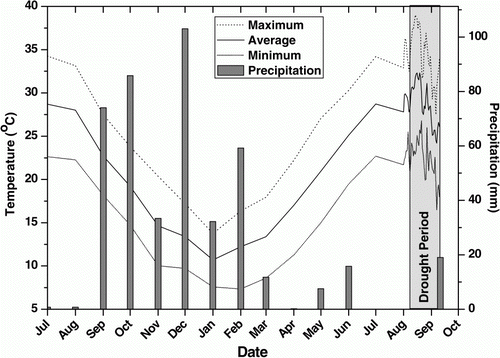
Turfgrass management
Between 20 Aug. and end of Sept. 2009, the plots were irrigated once a day in order to promote the establishment of the Manila grass plugs and prevent moisture stress and the plots were left without irrigation thereafter due to the occurrence of natural precipitation. Irrigation initiated again on 20 Mar. 2010, and was applied every other day until the initiation of the drought stress treatment (10 Aug. 2010). Granular fertilizer (Complesal 12-12-17, with a nitrogen content of 6.5% as NH4 + and 5.5% as NO3, 12N-5.2P-14.1K-1.2Mg-8.0S; Agrevo Hellas S.A., Greece) was applied on 2 Oct. 2009, and 21 May and 16 June 2010 at a rate of 25 g m-2 totalling an amount of 9 g N m −2, 3.9 g P m −2 and 10.6 g K m−2.
The experimental plots were left unmowed during 2009 due to the limited vertical turfgrass growth. In 4 Aug. 2010, before the initiation of the drought period, the plots were mowed to a height of 60 mm using an electric lawnmower (Rotak 320, Bosch GmbH, Germany).
Turfgrass measurements
The percentage of Z. matrella ‘Zeon’ green turf cover (GTC) was determined using digital images according to Richardson et al. (Citation2001). The water stress treatments were initiated on 10 Aug. and ended on 10 Sept. 2010, coinciding with the first autumn rainfall (). Before the initiation of the drought stress period, each plot was irrigated with ample water (until drainage) to saturate the substrate fully and produce uniformly wet conditions across all of the plots. From then on, irrigation was applied every 3 days at a rate of 3 mm for the low and 6 mm for the high irrigation regime (approximately 12.5% and 25%, respectively, of the cumulated daily evaporation over the 3-day interval). The plots were hand irrigated with a hose equipped with a flow meter having a delivery accuracy of 0.1 L (Wohnungswasserzähler Typ ETR, Rossweiner Armaturen & Messgeräte GmbH & Co. oHG, Germany). During the drought stress period, the volumetric substrate moisture was determined every 3 days before the application of irrigation with the use of a handheld TDR moisture meter (HH2, Delta-T Devices, UK) in conjunction with a sensor that measured 65 mm in depth×45 mm in width (WET-2, Delta-T Devices). Stomatal resistance of the Manila grass was determined before each irrigation event, at noon, on non-cloudy days by a diffusion porometer (AP4, Delta-T Devices, UK). Measurements were made on the abaxial side of young fully expanded leaves. The spectral reflectance (NDVI) of the canopy was determined from each plot before each irrigation event between 12:00 and 14:00 h using two double-channel SKR 1800 sensors (Skye Instruments Ltd, Powys, UK). The sensors had centre wavelengths of 650 nm (Red) and 800 nm (near infrared – NIR) and a bandwidth of approximately 10 nm.
Statistical analyses
The plot arrangement followed a completely randomized design. For the 2-way factorial design during the establishment (substrate type and depth) the analysis of variance for the GTC was performed on the collected data using JMP®ver.8 statistical software (SAS Institute Inc., NC, USA), following the repeated measures model with the substrate type as the main plot, the substrate depth as the sub-plot and the time (sampling dates) as the sub-subplot.
For the 3-way factorial design during drought stress (substrate type and depth and irrigation regime), the main research interest was focused on the treatment effects on the growth factors of the turf (NVDI, GTC and stomatal resistance) and the substrate moisture at each separate sampling date. Therefore, further statistical analysis was performed using ANOVA of JMP®ver.8 statistical software to compare the treatment effects within each separate sampling date. The treatment means for all of the statistical analyses were compared using the Fisher's protected least significant difference (LSD) at a probability level p < 0.05.
Results and discussion
Substrate properties and moisture characteristic curves
Substrate characteristics such as the particle size distribution (A) and the pH, EC and organic matter (O.M.) fell within the FLL specifications (pH: 6.0–8.5; EC: 5224 µS cm 1; O.M. ≤ 65 g L 1) for extensive green roofs (FLL Citation2008). Water retention was increased in the peat-amended compared with the compost-amended substrate by approximately 1.5% at all tensions (Figure 2B) which is in accordance with other studies (Boniak et al. Citation2004). All of the nutrients were increased in the compost-amended substrate compared with peat () due to the increased concentration of N, P, K and Mg of the compost ().
Table II. Chemical and physical characteristics of the peat-amended (S15:Pum40:Per20:P20:Z5), and the compost-amended (S15:Pum40:Per20:C20:Z5) substrates (S = sandy loam soil, Pum = pumice, Per = perlite, P = peat, C = compost, Z = zeolite).
Turf establishment and growth
Turfgrass growth, as indicated by the GTC, showed a minimum increase from the establishment date (20 Aug. 2009) until 1 Nov. 2009. After that date, Manila grass slowly entered dormancy (). The environmental conditions during the fall and winter were mild, being 2–3 oC above the 50-year mean temperature values () thus Manila grass did not become fully dormant because it did not completely loose its colour during the winter. In early March, dormancy was terminated and the Manila grass initiated its spring growth and completely covered the area of the experimental plots by late July 2010. It was noted that, during the first year, the Manila grass had minimum coverage, and the GTC remained below 40% (), confirming the slow establishment rate of Z. matrella (Volterrani et al. Citation2010), which was exacerbated by limited fertilizer application to simulate extensive green roof conditions. In the second year (2010), the coverage also developed slowly, but the coverage rate was improved after initiating fertilizer applications in the spring and summer reaching full coverage (98.8–99.2% GTC) by 15 July 2010. The latter fertilizer applications were necessary for equilibrating the turf before the initiation of the water-stress treatments.
Figure 2. A. Particle size distribution of the substrates. The grey area represents the specified particle size range by FLL (2008). B. Volumetric water potential curves for the substrate S15:Pum40:Per20:P20:Z5 or S15:Pum40:Per20:C20:Z5 (S = sandy loam soil, Pum = pumice, Per = perlite, P = peat, C = compost, Z =zeolite).
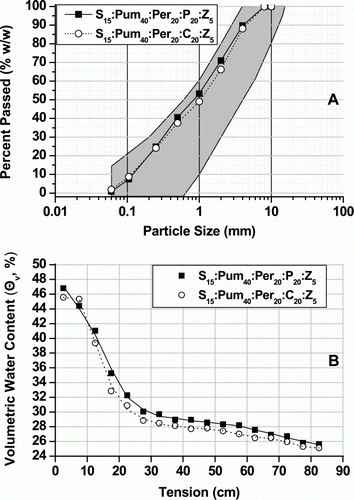
Figure 3. Green turf cover (%), as affected by substrate type (S15:Pum40:Per20:P20:Z5 or S15:Pum40:Per20:C20:Z5 where S = sandy loam soil, Pum = pumice, Per = perlite, P = peat, C = compost, Z = zeolite) and substrate depth (7.5 cm or 15 cm) during the establishment and growth period from 20 Aug. 2009 – 15 July 2010 (F designates the dates of fertilizer application, 2 Oct. 2009 and 21 May and 16 June 2010). Values are the mean of 12 replications. Bars represents Fisher's least significance difference (LSD) at p<0.05 following the repeated measures model. The asterisk (*) represents significant differences in-between treatment means on a single sampling date.
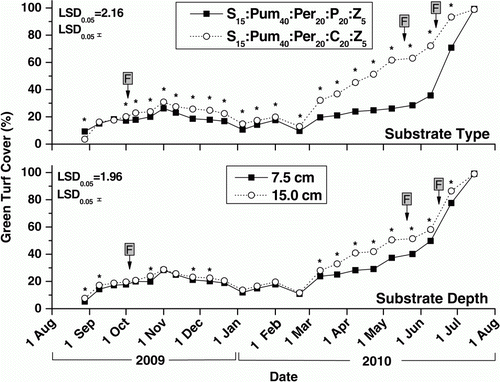
Both the substrate type and depth significantly affected the establishment and growth of Z. matrella (). In 2009, the substrate amended with compost showed significantly increased GTCs compared with the peat due to the higher nutritional status of the compost ( and ). This separation between the compost- and peat-amended substrates was also evident during the dormancy period and the spring of 2010 and was negated only after the fertilizer applications initiated in late spring ().
Substrate depth significantly improved the GTC during the spring of 2010, as the deeper profiles (15 cm) provided a better GTC compared with the shallow ones (7.5 cm). The benefit of the deeper substrates was negated in July 2010 when the turf cover was equilibrated before the imposition of the water-stress treatment due to the irrigation applied (). Small differences were also evident during 2009 indicating a trend of the beneficial impact of the deeper substrates. As expected, the deeper substrates provided better turf growth due to the higher moisture retention, the larger available root volume for root growth and the expected amelioration of the temperature extremes both in the winter and summer (Boivin et al. Citation2001). Concerning the influence of soil depth, Steinke et al. (Citation2010) reported that 10 cm of depth in a native silty clay soil failed to support Cynodon dactylon and Buchloe dactyloides growth in prolonged drought treatments.
Drought period
During the water-stress period (10 Aug. until 10 Sept. 2010), the substrate moisture quickly declined during the first 10 days (). Differences between the moisture contents of the two substrates were minimal and were evident only 6 and 9 days after the initiation of the water stress treatments with the peat-amended substrate having increased substrate moisture compared with the compost-amended substrate.
Figure 4. Substrate moisture (% v/v) at 65 mm depth, as affected by substrate type (S15:Pum40:Per20:P20:Z5 or S15:Pum40:Per20:C20:Z5 where S = sandy loam soil, Pum = pumice, Per = perlite, P = peat, C = compost, Z = zeolite), substrate depth (7.5 or 15 cm) and irrigation regimes (3 mm or 6 mm) during the water-stress period (10 Aug. – 10 Sept. 2010). Values are the mean of 6 replications. Bars represents Fisher's least significance difference (LSD) at p<0.05.
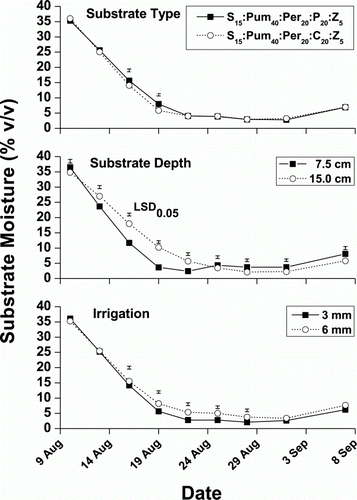
In contrast, differences in the moisture content between the two substrate depths were more pronounced. More specifically, the deeper substrates had a higher moisture content during the quick drying stage of the substrates (13–22 Aug. 2010), whereas the shallow substrates exhibited a higher moisture at the first sampling date (10 Aug. 2010) and during the severe water-stress period (25 Aug. until 10 Sept. 2010).
The increase of moisture of the shallow substrates from 25 Aug. until 10 Sept. 2010 can be attributed to the quicker induction into stress dormancy of the Manila grass grown in the 7.5-cm substrate depth, which was substantiated by the GTC and NDVI measurements ( and ), thus minimizing transpiration losses and resulting in an increase of the substrate moisture. The irrigation regime also affected substrate moisture because the increased amount of 6 mm increased the substrate moisture compared with the irrigation of 3 mm from 16 Aug. until the end of the drought period (10 Sept. 2010).
Figure 5. Green turf cover (%), as affected by substrate type (S15:Pum40:Per20:P20:Z5 or S15:Pum40:Per20:C20:Z5, where S = sandy loam soil, Pum = pumice, Per = perlite, P = peat, C = compost, Z = zeolite), substrate depth (7.5 cm or 15 cm) and irrigation regimes (3 mm or 6 mm) during the water-stress period (10 Aug. – 10 Sept. 2010). Values are the mean of 6 replications. Bars represents Fisher's least significance difference (LSD) at p<0.05.

Figure 6. Normalized Vegetation Difference Index, as affected by substrate type (S15:Pum40:Per20:P20:Z5 or S15:Pum40:Per20:C20:Z5, where S = sandy loam soil, Pum = pumice, Per = perlite, P = peat, C = compost, Z = zeolite), substrate depth (7.5 cm or 15 cm) and irrigation regimes (3 mm or 6 mm) during the water-stress period (10 Aug. – 10 Sept. 2010). Values are the mean of 6 replications. Bars represents Fisher's least significance difference (LSD) at p<0.05.
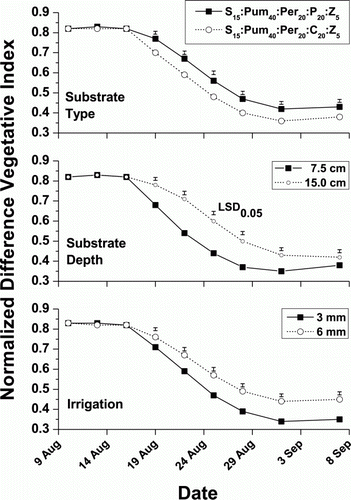
GTC and NDVI provided similar results during the implementation of water stress. More specifically, they were moderately affected by the substrate type and the irrigation regime and greatly affected by the substrate depth ( and ). The GTC was improved in the substrate that was amended with peat compared with the compost-amended substrate at five out of the nine measurement dates (). It seems that Manila grass growing in compost-amended substrate produced lusher growth compared with peat due to its higher nutritional status and thus produced plants that had difficulty to acclimatize in the drought summer conditions. Ebdon et al. (Citation1999) found increased evapotranspiration resulting from increased shoot growth as N fertilization increased in Poa pratensis. Similarly Nagase and Dunnett (Citation2011) reported that increasing the organic matter more than 10% by weight reduced the drought tolerance of plants due to the promotion of lush foliage growth.
The increased irrigation regime of 6 mm provided a better GTC compared with the 3 mm regime from 16 Aug. until the end of drought period. The deeper substrates provided the most significant improvement in the GTC, but the differences were minimal after 28 Aug. 2010, 15 days after the initiation of water stress. Based on all of the above results, the Manila grass growth started to decline 6 days after the initiation of drought and was completely halted after 18 days ().
As an overall indicator of the Manila grass condition, the NDVI further supported the findings of the previous measurements (). The peat amended substrate, the deeper substrates and the higher irrigation regime of 6 mm exhibited higher NDVI values on all measurement dates () indicating a better physiological condition and growth of the grasses under the specific treatments. At the end of the drought period the NDVI difference between the treatments of the three factors was most pronounced in the irrigation () with the 6 mm irrigation providing the highest value of 0.45 and the 3 mm irrigation the lowest (0.35).
In contrast to the above-mentioned measurements stomatal resistance was lower in the substrate amended with peat, the 15 cm substrate depth and the high irrigation regime further substantiating that plants that grew either in the compost-amended substrate or the shallow profiles or under a low irrigation regime were more stressed ().
Figure 7. Leaf stomatal resistance (s cm-1), as affected by substrate type (S15:Pum40:Per20:P20:Z5 or S15:Pum40:Per20:C20:Z5, where S = sandy loam soil, Pum = pumice, Per = perlite, P = peat, C = compost, Z = zeolite), depth (7.5 cm or 15 cm) and irrigation regimes (3 mm or 6 mm) during the water-stress period (10 Aug. – 10 Sept. 2010). Values are the mean of 6 replications. Bars represents Fisher's least significance difference (LSD) at p<0.05.
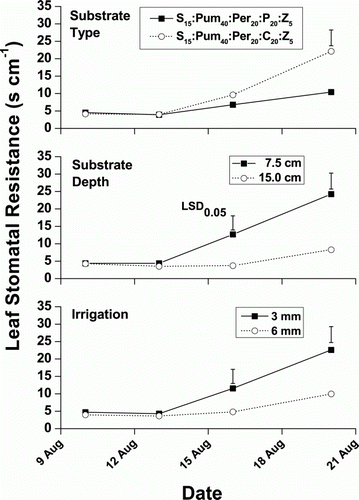
Conclusions
Based on the current results, Z. matrella ‘Zeon’ established on semi-extensive green roofs responded positively to the increase of substrate depth. In addition, the sustainability of the green roof can be accomplished only if irrigation is applied in amounts that exceed 25% of the Epan. Locally produced compost has the capacity to successfully substitute peat as a green roof substrate constituent for turfgrass establishment; however further research is required to evaluate its effects during drought in the absence of fertilization.
Acknowledgements
The authors thank L. Cambanis S.A. for providing the compost and LAVA, Mineral & Quarry S.A. for their partial funding support.This article is a portion of a PhD dissertation to be submitted by Ntoulas N.The mention of a trade mark, proprietary product, or vendor does not imply endorsement by the authors, nor does it imply approval to the exclusion of other products that may also be suitable.
References
- Akbari , H. , Pomerrantz , M. and Taha , H. 2001 . Cool surfaces and shade trees to reduce energy use and improve air quality in urban areas . Solar Energy , 70 : 295 – 310 .
- ASTM D 422-63 2007 . Standard test method for particle-size analysis of soils . West Conshohocken , PA : American Society for Testing and Materials .
- Beard , J. B. and Green , R. L. 1994 . The role of turfgrasses in environmental protection and their benefits to humans . Journal of Environmental Quality , 23 : 452 – 460 .
- Boivin , M. , Lamy , M. , Gosselin , A. and Dansereau , B. 2001 . Effect of artificial substrate depth on freezing injury of six herbaceous perennials grown in a green roof system . HortTechnology , 11 : 409 – 412 .
- Boniak , R. , Clark , J. , Chong , S.-K. and Indorante , S. J. 2004 . Bentgrass response and rootzone mixes properties as affected by the amendment of various treated organic wastes . Acta Horticulturae , 661 : 65 – 69 .
- De Luca , A. , Volterrani , M. , Gaetani , M. , Grossi , N. , Croce , P. , Mocioni , M. , Lulli , F. , & Magni , S. 2008 . Warm-season turfgrass adaptation in northern Italy . Proceedings of the 1st ETS Conference , 19–20 May 2008 , Pisa , , Italy . pp. 75 – 76 .
- Dunnett , N. and Nolan , A. 2002 . The effect of substrate depth and supplementary watering on the growth of nine herbaceous perennials in a semi-extensive green roof . Acta Horticulturae , 643 : 305 – 309 .
- Dunnett , N. and Kingsbury , N. 2010 . Planting green roofs and living walls , 2nd Edn , Timber Press : Cambridge: .
- Ebdon , J. S. , Petrovic , A. M. and White , R. A. 1999 . Interaction of nitrogen, phosphorus, and potassium on evapotranspiration rate and growth of Kentucky bluegrass . Crop Science , 39 : 209 – 218 .
- Feng , C. , Meng , Q. and Zhang , Y. 2010 . Theoretical and experimental analysis of the energy balance of extensive green roofs . Energy and Buildings , 42 : 959 – 965 .
- FLL-Forschungsgesellschaft Landschaftsentwicklung Landschaftsbau e.V 2008 . Richtlinien für die Planung, Ausführung und Pflege von Dachbegrünungen. Richtlinien für Dachbegrünungen (Guideline for the planning, execution and upkeep of green-roof sites) . Selbstverlag , , Troisdorf. (In German) .
- Getter , L. K. and Rowe , D. B. 2006 . The role of extensive green roofs in sustainable development . HortScience , 41 : 1276 – 1285 .
- Kotsiris , G. , Androutsopoulos , A. , Polychroni , E. and Nektarios , P. A. 2012a . Dynamic U-value estimation and energy simulation for green roofs . Energy and Buildings , 45 : 240 – 249 .
- Kotsiris , G. , Nektarios , P. A. and Paraskevopoulou , A. T. 2012b . Lavandula angustifolia growth and physiology is affected by substrate type and depth when grown under Mediterranean semi-intensive green roof conditions . HortScience , 47 : 311 – 317 .
- Liu , H. , McCarty , L. B. , Wells , C. E. , Baldwin , C. M. and Brown , P. J. 2005 . A greenhouse establishment study comparing peanut shell bio-solid with peat moss as an organic source for root zone mix . International Turfgrass Society Research Journal , 10 : 1108 – 1114 .
- Morris , K. 2001 . National zoysiagrass test 1996 . National Turfgrass Evaluation Program . Final Report 1997–2000, NTEP No. 01–15 .
- Nagase , A. and Dunnett , N. 2011 . The relationship between percentage of organic matter in substrate and plant growth in extensive green roofs . Landscape and Urban Planning , 103 : 230 – 236 .
- Nektarios , P. A. , Amountzias , I. , Kokkinou , I. and Ntoulas , N. 2011a . Green roof substrate type and depth affects the growth of the native species Dianthus fruticosus under reduced irrigation regimens . HortScience , 46 : 1208 – 1216 .
- Nektarios , P. A. , Kastritsis , S. , Ntoulas , N. and Tsiotsiopoulou , P. 2011b . Substrate amendment effects on potted plant production and dry weight partition of Lantana camara . HortScience , 46 : 864 – 869 .
- Nektarios , P. A. , Ntoulas , N. , McElroy , S. , Volterrani , M. and Arbis , G. 2011c . Effect of olive mill compost on native soil characteristics and tall fescue turfgrass development . Agronomy Journal , 103 : 1524 – 1531 .
- Ntoulas , N. , Nektarios , P. A. and Gogoula , G. 2011 . Evaluation of olive mill waste compost as a soil amendment for Cynodon dactylon turf establishment, growth and anchorage . HortScience , 46 : 937 – 945 .
- Richardson , M. D. , Karcher , D. E. and Purcell , L. C. 2001 . Quantifying turfgrass cover using digital image analysis . Crop Science , 41 : 1884 – 1888 .
- Steinke , K. , Chalmers , D. , Thomas , J. and White , R. 2010 . Bermudagrass and buffalograss drought response and recovery at two soil depths . Crop Science , 51 : 1215 – 1223 .
- Takebayashi , H. and Moriyama , M. 2007 . Surface heat budget on green roof and high reflection roof for mitigation of urban heat island . Building and Environment , 42 : 2971 – 2979 .
- Volterrani , M. , Grossi , N. , Gaetani , M. and Pompeiano , A. 2010 . Zoysiagrass cultivar establishment rate and turf quality in central Italy . Acta Horticulturae , 881 : 313 – 316 .